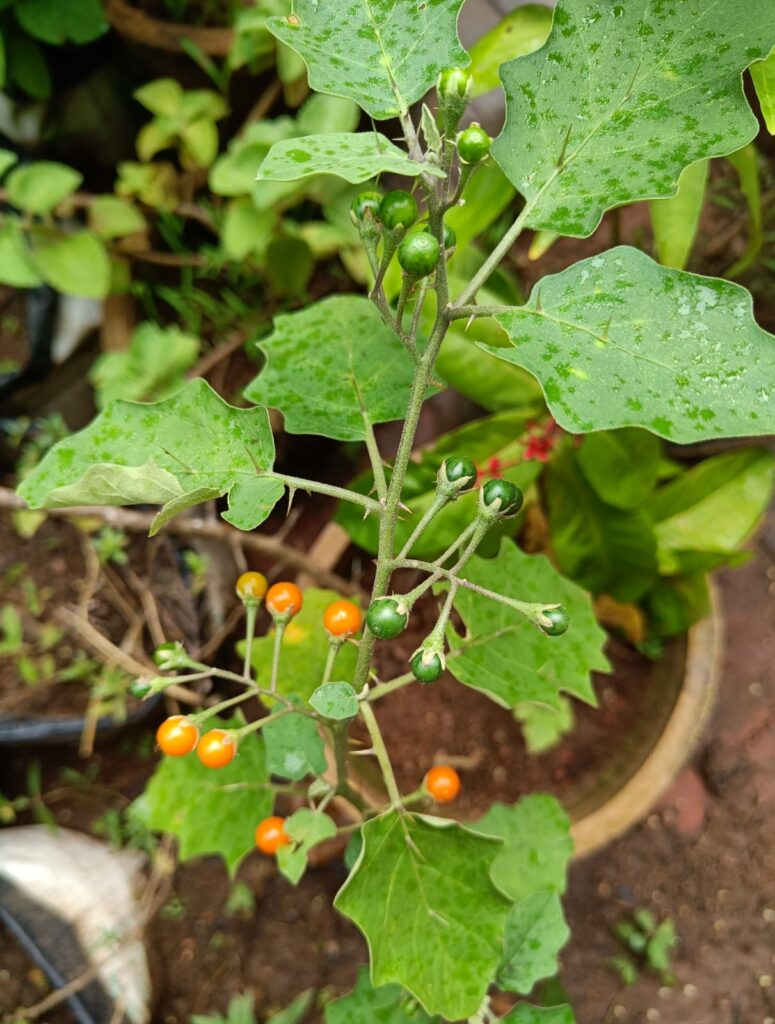Welcome to your holistic living

Botanical Name: Solanum indicum Linn
Family: Solanaceae
English Name: Indian night shade
Malayalam Name: Cheruchunda
Hindi Name: Banabhanta
This plant is a large, much-branched, perennial erect undershrub, 0.5–1.5 m tall, growing wild throughout India, especially in tropical and subtropical regions, and commonly found along roadsides, wastelands, hedges, gardens, and open forests. It prefers sunny locations with well-drained sandy to loamy soils and is distributed up to an altitude of about 1500 meters in the Himalayan region, as well as in Sri Lanka, Nepal, Bangladesh, and other South Asian countries. The stem is cylindrical, hairy, and often armed with prickles, while the leaves are 5–10 cm long, ovate or elliptic, lobed, with prickles on the veins, and hairy on the surface. The flowers are purple or bluish, borne in clusters as corymbose cymes. The fruits are small, globose berries, 1–1.5 cm in diameter, green when unripe and yellow on ripening, containing numerous yellowish, flat, kidney-shaped seeds.
Roots, fruit, leaves
Respiratory System Anti-asthmatic → Relieves bronchospasm and eases breathing in asthma. Expectorant → Promotes expulsion of phlegm from the airways. Bronchodilator → Widens bronchi, improving airflow in obstructive conditions. Digestive System Carminative → Reduces bloating and flatulence. Appetizer & Digestive stimulant → Improves appetite and promotes secretion of digestive juices. Anti-ulcer → Protects gastric lining and reduces hyperacidity. Immune System Immunomodulatory → Enhances immune defense by regulating cytokines and white blood cell activity. Musculoskeletal System Anti-inflammatory → Reduces inflammation in joints and muscles by suppressing inflammatory mediators. Analgesic → Provides pain relief in musculoskeletal conditions. Anti-arthritic → Helps in reducing stiffness and swelling in arthritic joints. Urinary System Diuretic → Promotes urine flow and aids detoxification. General / Multi-systemic Antioxidant → Neutralizes free radicals and protects tissues. Antimicrobial → Inhibits bacterial and fungal infections. Febrifuge / Antipyretic → Helps reduce fever.
Anti-inflammatory – Reduces inflammation (Śothahara), useful in bronchitis, arthritis, and inflammatory conditions,Analgesic – Relieves pain (Vedanasthāpana), helpful in colic, headache, and muscular pain,Antiasthmatic & Bronchodilator – Relieves bronchospasm, improves airflow; classically indicated in Śvāsa–Kāsa 4. Expectorant (Mucolytic) – Helps expel mucus from respiratory tract 5. Antipyretic – Reduces fever (Jvaraghna). 6. Antimicrobial – Active against bacteria and fungi, helpful in skin diseases and infections. 7. Diuretic – Increases urine output, reducing edema (Mutrala). 8. Antioxidant – Neutralizes free radicals, protective against tissue damage. 9. Hepatoprotective – Some studies show liver-protective effect. 10. Antiulcer – Reduces gastric irritation and ulcer formation.
Rasa: Katu, Tikta
Guna: Laghu, Ruksha, Tikshna
Virya: Usna
Vipaka: Katu
Dosha Karma: Kaphavata shamaka